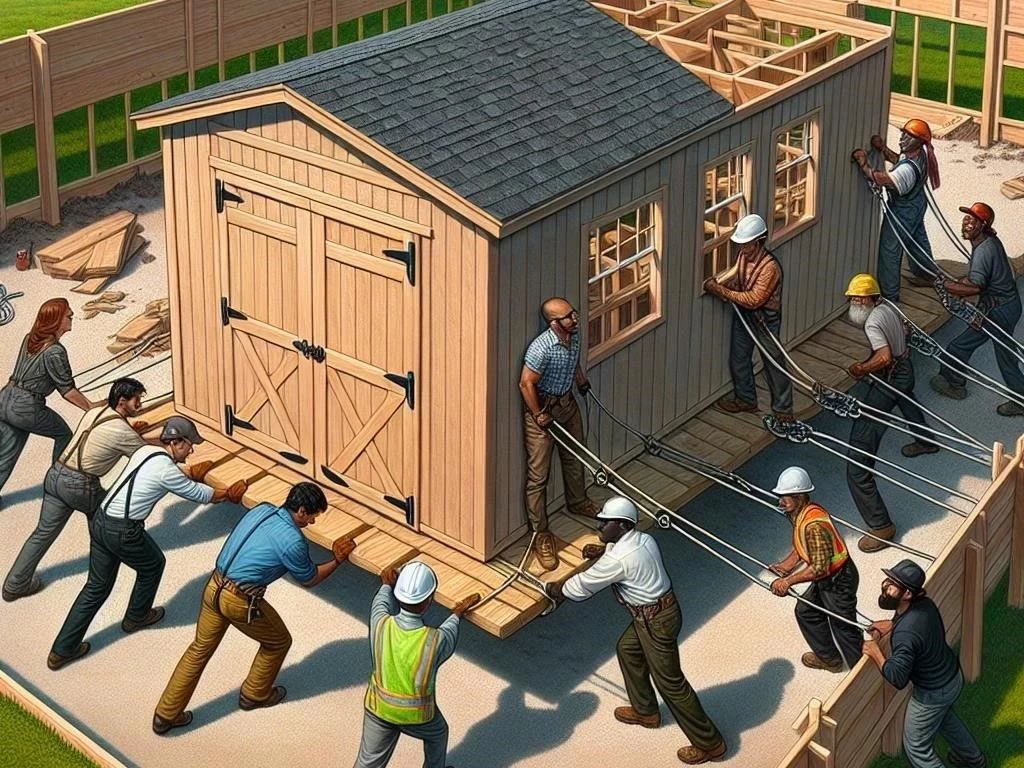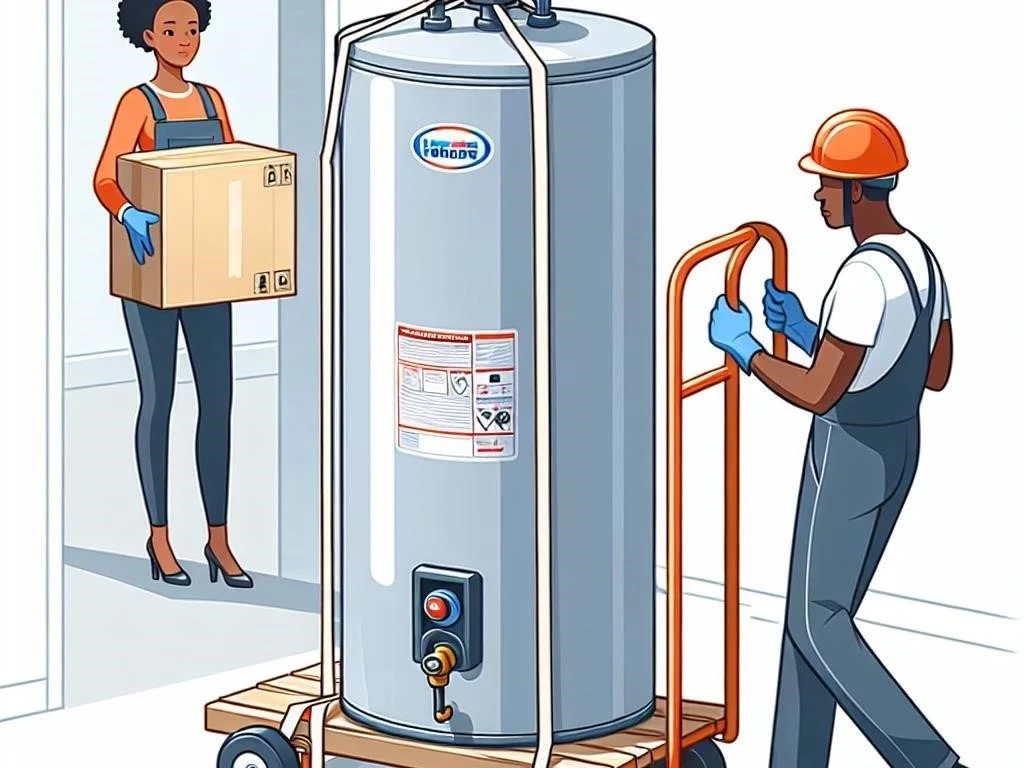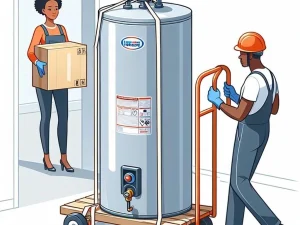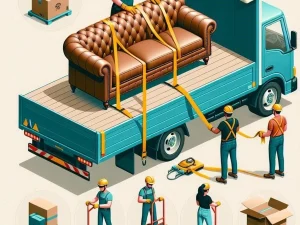How to Transport a Shed
Transporting a shed requires careful planning and execution. Consider appropriate equipment, safety measures, and techniques to ensure a successful and secure relocation process for your shed.
Understanding Shed Relocation
Shed relocation involves moving a portable shed from one site to another, ensuring it remains intact and functional. It’s crucial to recognize the various factors involved, including the size and weight of the shed, local regulations, and terrain. Proper planning is essential to avoid damage during transport. You must assess whether disassembly is necessary, as this can simplify the moving process. Additionally, having the right shed transport equipment, such as a trailer for shed hauling or shed moving tools, is vital. Understanding the best lifting techniques and utilizing shed skids can help facilitate heavy lifting. Always prioritize safety by considering secure shed transport methods and employing a shed moving service if needed. Proper organization will ensure a successful shed relocation experience.
Reasons for Moving a Shed
There are various reasons why you might consider moving a shed. One common reason is to create more space in your yard or to reposition it for better accessibility. Changing weather conditions or landscaping plans may also necessitate relocation. Additionally, you might want to place the shed closer to your home for easier access to tools and equipment. If you’re renovating your property or selling your home, relocating the shed can enhance your yard’s overall aesthetics and functionality. Furthermore, a portable shed can be moved to a new location if you’re relocating, ensuring that you maintain your storage solutions. Understanding these reasons can help you plan the shed transport effectively while optimizing its use in your space.
Planning Your Shed Move
Planning your shed move is crucial for a successful relocation. Begin by assessing the size and weight of the shed to determine the appropriate moving equipment needed. Make a checklist of essential shed moving tools, including lifting equipment and securing straps. Next, choose a new location that is level and accessible, ensuring it aligns with local regulations. It’s also important to consider any obstacles, such as trees or fences, that may hinder the moving process. If disassembly is required, plan how to dismantle the shed efficiently, and ensure you have the necessary tools ready. Additionally, inform any neighbors about the upcoming move, as this can help avoid any disturbances. A well-thought-out plan can significantly streamline your shed transport experience;
3.1 Assessing the Size and Weight of the Shed
Assessing the size and weight of your shed is a critical step in the relocation process. Start by measuring the dimensions of the shed, including its height, width, and length. This information will help you determine if you need a special trailer for shed transport or additional moving equipment for shed hauling. Next, weigh the shed to understand its heaviness, as this will affect the lifting techniques and tools required. It’s essential to consider the materials used in the shed’s construction, as some materials may be heavier than others. Additionally, identify any contents inside the shed that may contribute to the overall weight. By accurately assessing these factors, you can plan effectively for a secure and efficient shed transport experience.
3.2 Choosing the Right Location for Your Shed
Choosing the right location for your shed is essential for functionality and convenience. First, select a flat, stable area that can support the weight of the shed and withstand weather conditions. Avoid low-lying areas prone to flooding, and ensure proper drainage around the site. Accessibility is also key; place the shed within easy reach of your home or frequently used areas. Consider sunlight exposure, as sufficient natural light can be beneficial, especially if you plan to use the shed for gardening or as a workspace. Additionally, check local zoning regulations to ensure compliance with property lines and permits. By thoughtfully selecting a location, you can enhance the use of your shed while ensuring its longevity and ease of access.
Preparing for Shed Disassembly
Preparing for shed disassembly is crucial for a smooth relocation. Begin by clearing the area around the shed to create a safe workspace. Gather all necessary tools for dismantling, including screwdrivers, wrenches, and a pry bar. Ensure you have shed moving tools ready, such as a saw for cutting any stubborn parts. Before starting, take photos of the shed’s structure to aid in reassembly at the new location. Label all components, including screws and panels, to simplify the process later. It’s also wise to wear safety gear, such as gloves and goggles, to protect yourself from debris and sharp edges during disassembly. By taking these steps, you can ensure an organized and efficient dismantling process, making shed transport significantly easier.
4.1 Tools Needed for Dismantling Shed
When preparing to dismantle a shed, having the right tools is essential for efficiency and safety. Start with basic hand tools such as screwdrivers and pliers for removing screws and bolts. A wrench set will also be useful for loosening any nuts or fasteners. A pry bar can help separate panels or materials that are tightly fitted together. Additionally, consider a reciprocating saw or circular saw for cutting through any wood or metal components. Don’t forget safety gear, including gloves, goggles, and a hard hat, to protect against injuries. A hammer may be necessary for driving out nails or securing loose parts. Properly equipping yourself with these tools will facilitate a smoother dismantling process, ensuring readiness for transporting your shed.
4.2 Safety Precautions for Shed Dismantling
Prioritizing safety during shed dismantling is essential to prevent accidents and injuries. First, ensure the area is clear of obstacles to avoid tripping while working. Wear appropriate safety gear, including gloves, goggles, and a hard hat, to protect yourself from falling debris and sharp edges. Use sturdy ladders when reaching higher parts of the shed, ensuring they are placed on stable ground. Always work with a partner if possible, as assistance can help with heavy lifting and provide support during disassembly. Be cautious when using power tools; read the instructions and follow proper operating procedures. Additionally, be mindful of any electrical wiring or plumbing that may be present. Following these safety precautions will ensure a smooth and secure dismantling process.
Shed Moving Tips
Successfully moving a shed requires careful planning and execution. First, utilize shed skids, which are sturdy wooden beams placed underneath the shed to facilitate easier lifting and transport. This method can significantly reduce the effort needed during the relocation process. Next, practice proper heavy lifting techniques to avoid injuries; ensure you lift with your legs and maintain a stable posture. When using a trailer for shed transport, confirm that it can accommodate the shed’s weight and dimensions. Secure the shed properly using straps or ropes to prevent movement during transport. If possible, collaborate with friends or hire a shed moving service for additional support. Lastly, ensure that you assess the route for any obstacles, such as low branches or narrow passages, to ensure a smooth relocation.
5.1 Using Shed Skids for Easier Lifting
Using shed skids is an effective method for facilitating the lifting and transport of your shed. Shed skids are typically made from heavy-duty wood, designed to support the weight of the shed while providing stability. Begin by measuring the shed’s dimensions to determine the appropriate size for the skids. Position the skids under the shed’s base, ensuring they are evenly spaced to distribute weight effectively. When lifting, use a combination of manpower and lifting tools, such as jacks, to elevate the shed slightly, allowing the skids to slide underneath. This technique minimizes the risk of damage to the shed’s structure and makes it easier to move. By employing shed skids, you can enhance maneuverability and simplify the relocation process significantly.
5.2 Heavy Lifting Techniques
Employing proper heavy lifting techniques is essential when transporting a shed to prevent injuries and ensure a smooth move. Start by assessing the weight and dimensions of the shed to determine if additional help is needed. Always lift with your legs rather than your back; this technique distributes the weight more evenly and reduces strain. When preparing to lift, position yourself close to the object, keeping your feet shoulder-width apart for stability. Use a firm grip on the shed’s edges and coordinate with your team if lifting with others. Consider using lifting straps or a dolly to assist with the move, which can make the process more manageable. Take breaks if needed, and communicate clearly with your team to ensure everyone is aligned during the lifting process.
Shed Transport Equipment
Choosing the right shed transport equipment is crucial for a successful relocation. Start with a suitable trailer for shed transport, ensuring it can accommodate the shed’s weight and size. Look for a flatbed trailer or a specialized shed-moving trailer that provides stability during transit. Additionally, ensure you have proper securing equipment such as straps, ropes, or chains to keep the shed in place while transporting. If the shed is particularly heavy, consider using hydraulic jacks or dollies to assist in lifting it onto the trailer safely. A winch can also be beneficial for pulling the shed up the ramp onto the trailer. Having the right equipment not only ensures safety but also streamlines the entire moving process, making it more efficient and effective.
6.1 Selecting a Trailer for Shed Transport
Selecting the right trailer for shed transport is essential for ensuring a safe and efficient relocation. Begin by determining the dimensions and weight of your shed to identify the appropriate trailer size. Flatbed trailers are often ideal, providing ample space and stability. Ensure the trailer has a weight capacity that exceeds the shed’s total weight, accounting for any additional items inside. Check for features like ramps, which facilitate easier loading and unloading. Additionally, consider trailers with side rails or tie-down points to secure the shed during transport, preventing movement or damage. If you’re unsure, consult with a rental company that specializes in trailers to find the best option for your specific needs. Proper trailer selection will contribute to a smooth shed transport experience.
6.2 Shed Moving Tools You Will Need
Having the right shed moving tools is crucial for a successful transport process. Start with basic hand tools such as screwdrivers, wrenches, and pliers for disassembly. A reciprocating saw may be necessary for cutting through stubborn materials. Heavy-duty lifting straps or slings can assist in safely lifting the shed, distributing weight evenly. Additionally, hydraulic jacks can elevate the shed, making it easier to place skids underneath. A dolly or furniture mover will help in maneuvering the shed once it’s off the ground. Don’t forget securing tools like ratchet straps or bungee cords to ensure the shed remains stable during transit. Lastly, consider a hammer for any necessary adjustments or securing loose components. With these tools, you can streamline the shed moving process significantly.
Shed Moving Service Options
When considering a shed relocation, exploring shed moving service options can significantly simplify the process. Professional moving services specialize in shed transport, providing expertise and equipment necessary for a safe and efficient move. Start by researching local companies that offer shed moving services, checking reviews and ratings to assess their reliability. Some services may include disassembly and reassembly, which can save you time and effort. Compare pricing and packages to ensure they meet your budget and needs. Additionally, inquire about their insurance policies to protect your shed during transport. If you prefer a DIY approach, consider renting equipment from these companies for a more hands-on experience. Ultimately, the right service option will enhance your shed moving experience, ensuring a smooth transition to the new location.
7.1 Pros and Cons of Hiring Professionals
Hiring professionals for shed transport comes with several pros and cons to consider. On the positive side, professionals have the experience and expertise to manage the entire process efficiently, ensuring safe handling and transport of your shed. They possess specialized equipment and tools, minimizing the risk of damage during relocation. Additionally, hiring experts can save you time and energy, allowing you to focus on other tasks. However, there are cons to consider as well. Professional services can be costly, potentially exceeding your budget, especially for larger sheds. There may also be scheduling conflicts, as you’ll need to coordinate with their availability. Weighing these pros and cons can help you determine if hiring professionals is the right choice for your specific shed transport needs.
7.2 Finding Reliable Shed Moving Services
Finding reliable shed moving services requires thorough research and careful consideration. Start by asking friends or family for recommendations; personal experiences can provide valuable insights. Online reviews and ratings on platforms like Yelp or Google can help identify reputable companies. When contacting potential services, inquire about their experience specifically with shed transport, as this ensures they understand the unique challenges involved. Request quotes from multiple companies to compare pricing and services offered, ensuring transparency in costs. Additionally, check if they are licensed and insured, providing protection in case of damage during transport. Finally, consider scheduling consultations to discuss your specific needs, allowing you to gauge their professionalism and commitment. Taking these steps will lead you to a dependable shed moving service.
Secure Shed Transport
Ensuring secure shed transport is essential to prevent damage during relocation. Start by properly securing the shed to the trailer, using heavy-duty straps or ratchet ties to hold it in place. Double-check that the shed is centered on the trailer to maintain balance while driving. If the shed has any loose parts, such as windows or doors, ensure they are either secured or removed to avoid breakage. Additionally, consider using moving blankets or padding to protect the shed’s surfaces from scratches and dents. Before hitting the road, inspect your route for potential obstacles, such as low bridges or narrow streets. Driving at a moderate speed will minimize the risk of sudden movements, ensuring a safe journey for your shed. Proper preparation will lead to successful transport.
8.1 Ensuring Safe and Stable Transport
Ensuring safe and stable transport of your shed is critical to avoid accidents and damage. Begin by thoroughly inspecting the trailer before loading, checking for any signs of wear or structural issues. When loading the shed, use a level surface to ensure it is positioned correctly on the trailer. Secure the shed with heavy-duty straps across the width and length, ensuring it cannot shift during transit. If using skids, ensure they are adequately placed to support weight evenly. Additionally, drive cautiously, avoiding sharp turns and sudden stops to maintain stability. Regularly check your mirrors to monitor the shed’s position while driving. Lastly, consider traveling during off-peak hours to reduce the risk of heavy traffic, allowing for a more controlled transport experience.
8.2 Tips for Effective Shed Hauling
Effective shed hauling requires careful preparation and attention to detail. First, ensure that your vehicle is capable of towing the shed’s weight, checking the towing capacity against the shed’s specifications. Use a reliable trailer equipped with proper tie-down points for secure attachment. Before setting off, double-check all straps to confirm they are tight and secure, preventing any movement during transport. Plan your route ahead of time, avoiding areas with low bridges or narrow streets that may pose challenges. When driving, maintain a steady speed and avoid sudden maneuvers, as they can destabilize the load. Regularly stop to inspect the shed’s positioning and the integrity of the securing straps. Following these tips will enhance safety and effectiveness during the shed hauling process.
Assembling Your Shed at the New Location
Assembling your shed at the new location is a crucial step in the relocation process. First, ensure the site is level and adequately prepared, allowing for proper drainage and stability. Begin by unpacking all components and organizing them according to the assembly instructions. Use the necessary tools, such as screwdrivers, a hammer, and wrenches, to facilitate the process. Start with the base, ensuring it is securely anchored to the ground, followed by erecting the walls. Pay close attention to alignments, ensuring everything is squared and level. Once the walls are in place, attach the roof, ensuring all connections are tight and secure. Finally, inspect the shed for any loose parts and make sure doors and windows operate correctly. Completing these steps will ensure a functional and stable shed.
9.1 Tools Required for Shed Assembly
Having the right tools is essential for a successful shed assembly at your new location. Start with basic hand tools, such as a hammer, screwdriver (both flathead and Phillips), and a set of wrenches for tightening bolts and screws. A level is crucial to ensure that the shed is assembled evenly and securely. You may also need a tape measure for accurate dimensions and alignments. For cutting or trimming any materials, a saw, either hand or power, can be useful. Additionally, consider using a drill for faster assembly, allowing you to drive screws efficiently. Safety goggles and gloves are also recommended to protect yourself during the assembly process. Finally, having a step ladder on hand will assist in reaching higher areas safely.
9.2 Final Checks After Shed Assembly
Conducting final checks after shed assembly is critical to ensure everything is in proper working order. Start by inspecting all joints and connections, confirming that screws and bolts are tightened securely. Check the alignment of doors and windows, ensuring they open and close smoothly without obstruction. Assess the roof for any leaks, especially if your shed will store sensitive materials. Verify that the floor is level and free from any gaps, which could lead to water intrusion or pest entry. Additionally, inspect the exterior for any loose boards or panels that may need reinforcement. Finally, clean up the area around the shed, removing any debris or tools left behind. Completing these checks will ensure your shed is functional, safe, and ready for use.














Post Comment